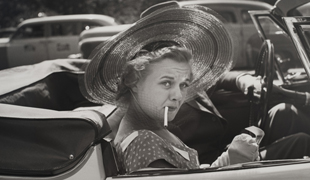[FR]
—
The movement for change is a changing movement, changing itself, demasculinizing itself, de-Westernizing itself, becoming a critical mass that is saying so in many different voices, languages, gestures, actions: It must change; we ourselves can change it.
We who are not the same. We who are many and do not want to be the same.
Adrienne Rich, « Notes toward a Politics of Location » 1

Fig. 1
Jimmie Durham, New Clear Family, 1989
Wood, bronze, beads, rope, paint, mixed materials
19 dolls, each approx. 18H; overall approx. 86 x 52 in. Courtesy of the artist, Museum van Hedendaagse Kunst, Anvers, and Christine König Galerie, Vienna © Jimmie Durham
The impact on the visual arts of what is generally—if vaguely—termed the multiculturalist debate has been profound. Its effects are manifest discursively as well as institutionally, locally as well as internationally; they can be gauged by an increasing amount of critical writing and media coverage as well as by a growing number of exhibitions organized around multiculturalist themes. Even more significant has been the emergence of dozens of artists who have made questions of racial, ethnic, or sexual identity central themes in their work. Mistaken Identities and its catalog are thus meant to participate in a discourse that is as much political as cultural. Unlike earlier debates around postmodernism in the visual arts, multiculturalism cannot be detached from political actuality here and abroad, including the current cataclysms of ethnic and national strife, the ongoing struggles for empowerment by people of color, and the frightening upwellings of racism and xenophobia.
Where postmodernist art theory fostered a heightened awareness of the politics of representation, feminism and multiculturalism have quickened and mobilized those politics. This has been accomplished by anchoring relatively abstract analyses of power and ideology to their concrete and material effects, particularly as these act upon or are experienced by subaltern (that is to say, subordinated) subjects. Broadly speaking, postmodernist theory has examined the theoretical construction of the Other in at least three overlapping forms: as an internal split in the subject, as the feminine Other of sexual difference, and as the Third World or diasporic Other—the “new” subject in history. However, it is feminism and multiculturalism that represent the lived subjectivity that postmodernism theorizes, the voices of those others. And while feminism and multiculturalism obviously have their academic incarnations, they are never only academic because they are also root and branch the expressions of political struggle. Within this struggle, culture—in both mass and elite forms—can be an important site for contestation and intervention.
Having said that, however, it is necessary immediately to add that multiculturalism in the arts—like the subject of identity itself—is by no means a self-evident or consensual concept. For example, is multiculturalism in the visual arts to be understood as a renewed version of cultural pluralism, a means by which the previously excluded gain entrance to the art—world emporium? Is it thus reducible to a politics of assimilation of what was previously euphemized as “minority” art? If this is so—if multiculturalism is taken to mean the assimilation of cultural difference to mainstream art culture—then it evades the more profound implications of its own critique. Which is to say that the significance of the multiculturalist debate does not so much lie in its recognition of diversity and difference per se, but in its consideration of differences, both in their historical specificity and in terms of the power relations in which they are moored.
The U.S. has always been a multicultural—and multiracial—society. Historically, this incontrovertible demographic fact has been framed within assimilationist models by which, for example, the singularity of the African-American or Native American experience has been incorporated (and simultaneously deracinated) within the model of European immigration. The pluralist acknowledgement of “diversity” has thus functioned to sidestep considerations of race and racism, to neutralize difference, just as it has blurred the distinctions between immigration, slavery, and the destruction of America’s indigenous populations.
One legacy of the political and social movements and struggles born (or reborn) in the crucible of the ’60s was to forever dispel the myth of the melting pot and its attendant fantasies of automatic assimilation. E pluribus unum, as it says on the dollar bill, has not only failed as hopeful prophecy, but been revealed as ideologically complicit in strategies of repression and erasure. Who or what is this “one” to be forged out of many? If, in our darkening fin-de-siecle, we see everywhere the conflicts and claims of difference, it must be acknowledged that all of our routinely-named distinctions—white/black, man/woman, straight/gay, plus all the hyphenated designations within nation and culture—are permeated with a violence that both underpins and ratifies their hierarchy. Insofar as it is always the second term that is “marked” as secondary, it necessarily follows that the mark of difference has been the inescapable burden of the Other. 2 From this recognition arises the politics of difference, be it a politics of affirmation (“Black is Beautiful,” “Gay Pride”) or a politics of opposition (“No justice, no peace”).
What therefore distinguishes the multiculturalist paradigm in its contemporary formulations is its reevaluation of constitutive differences and the dominant culture’s relation to them, and its raising of political and ethical questions about the role and consequences of these various differences within American (and by extension, European) life today.
Within this more politicized formulation, multiculturalism in the arts becomes not merely a question of who is doing the producing, but how that production relates to both art culture and culture at large. If multiculturalism in the arts is taken to mean a more activist, interventionist, and critical mobilization of the term “multiculturalism,” it is then crucial to understand how “minority” or multicultural art production actually functions, and how it positions itself in relation to dominant modes of expression and ideology. In this case, it becomes important to retain the concepts and intentions of critical practice, encompassing its composite lineage in twentieth-century avant—gardes and Frankfurt School theorizations, as well as its most recent formulations within postmodernist cultural theory. This more politicized model of multiculturalism in the visual arts exceeds pluralism in both its political and aesthetic definitions, and it is this more politicized inflection of the term that has underpinned the organization of Mistaken Identities.
In contrast to the committed pluralism of such important exhibitions as the 1990 The Decade Show, or the 1991 Interrogating Identity, Mistaken Identities presents a range of art production in which the political aspects of multiculturalism are embodied in critical practices concerning the ways that identity—racial, ethnic, or sexual—is imposed, projected, or fantasized. Such work fulfills Baudelaire’s now hoary dictum, “il faut être de son temps” (“It is necessary to be of one’s time”) in its strongest sense; that is, it addresses itself to the urgent issues of the contemporary moment. In this, it performs one of the most serious functions of art, a function that might be described as thinking historically and in visual form about the present.
Whether celebrated or deplored, the ubiquity and prominence of the multicultural debate is closely tied to contemporary debates about identity. Conversely, debates about identity and the emergence of identity politics are inseparable from debates around multiculturalism. Furthermore, the very act of examining how identity is constituted opens onto the realm of the political, for insofar as certain identities entail subordination and others dominance, the task is one of intervention as well as analysis.
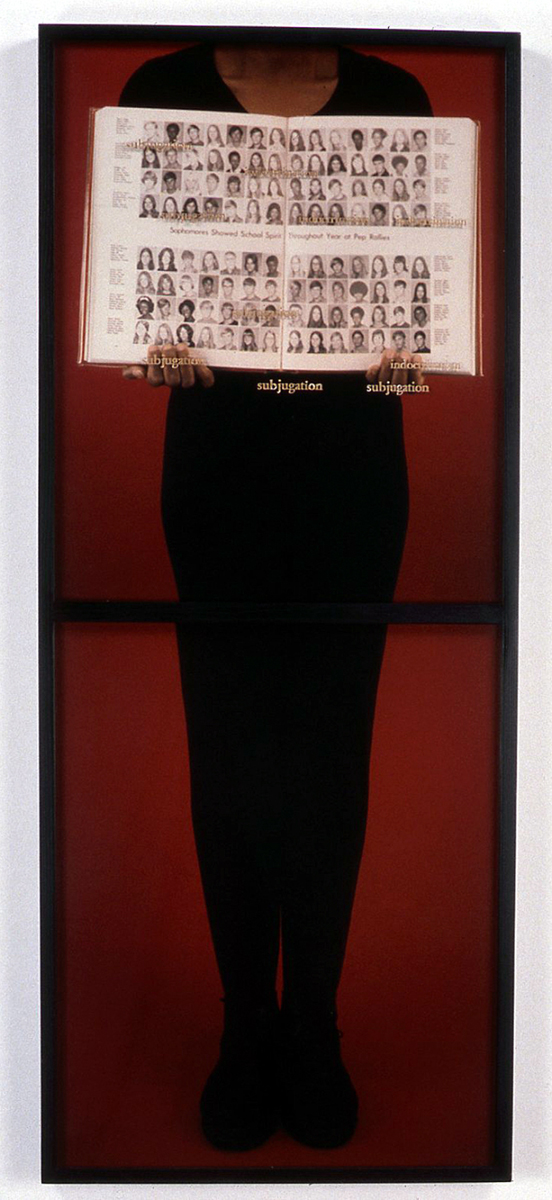
Fig.2
Lorna Simpson
H.S., 1992
Two color polaroïds with engraved Plexiglas, 40,5 x 20,5 in.
Courtesy of the artist © Lorna Simpson
That the concept of identity should have emerged as a central theme for artists in the past fifteen years or so is itself a vastly overdetermined development. On a global stage, the frame of postcolonialism, the formation of new nations and subjectivities, the radical dislocations and traumas caused by multinational capitalism, the cultural transformations metastasized by new communication technologies all operate to refigure and refashion identities, both collective and individual. Far from being an abstraction or the limited province of the personal, identity is now more than ever a motor of history, a fulcrum of crisis. It is this Janus face—both a lever of emancipation and enfranchisement (as in the struggles for national liberation in India, Africa, Algeria, Indochina, the socialist revolutions in Cuba and Nicaragua) and a contributing factor in the lethal whirlwind reaped in ongoing civil wars—that makes any consideration of identity as such so difficult. If the internationalist ideals of nineteenth-century socialism, or of the secular and religious peace movements of the twentieth century seem currently moot, it is perhaps more than ever necessary to confront the issue head on.
Nonetheless, it is important to establish thespecificity of the issues given form in Mistaken Identities and the contexts in which the art has been produced. For if indeed it is the case that the claims, contestations, and conundrums of individual and collective identity are everywhere manifest on the American scene, it by no means follows that “identity” in art or in life is either a simple or uncontested concept. We are in any case far—in time and in belief—from the putative universals and transcendent claims of modernist painting and sculpture. We are all inhabitants of a world of difference, the world of the postcolonial, post-Cold War, postmodern subject. The critical recognition that this subject is marked and shaped by race, by class, by gender, imprinted by histories that make him or her a beneficiary or victim of the existing world order, is the beginning of a recognition that the elision of difference is neither desirable nor, for that matter, possible (figs. 1 and 2). In this respect, and notwithstanding invocations of our common humanity, the artists who construct their Work in recognition of the claims of difference are necessarily operating within the sphere of the political.
Postmodern theory has itself contributed to the theoretical formulations around multiculturalism and identity, serving, for example, to foster the exploration of identity as a prime object of artistic investigation. Furthermore, postmodernism’s focus on subjectivity—its formation in culture and language and/or its historical crisis—has evolved into a concern with the many facets of identity as they collectively operate to constitute subjectivity. In this respect, among others, postmodernism remains an indispensable model for conceptualizing a profound shift in cultural production in the closing decades of the century. With respect to the art under discussion, this shift might be described, somewhat sweepingly, as the demise of the universal artist and the birth of a specific and historical one.
Placing the art of Mistaken Identities under the aegis of postmodernism is not, however, without its risks. To the extent that postmodernist art was originally theorized with no reference whatsoever to artists of color, to non-western cultural production, or to subaltern identities (excepting, and that belatedly, women) 3). Situating this art in such a way can function as yet another form of cultural imperialism. Consider, for example, Rasheed Araeen’s grim assessment:
When the others begin to demand their share of the modern pie, modernism became post-modernism: now there is “Western” culture and “other” cultures located within the same “contemporary” space…the concept of “others” as mere victims of dominant culture will be to deny other cultures their ability to question their domination and to liberate themselves from it. 4
Whether or not one agrees with Araeen’s notion of postmodernist culture, his disenchantment with its terms is by no means infrequently encountered among artists (and critics) of color. Many others seem unpersuaded by postmodernist theory’s claims to discursive transgression and/or subversion. Thus, Adrian Piper, who in many ways is the emblematic artist in this exhibition, does not especially identify herself with the poststructuralist project that has figured so prominently within postmodernist cultural theory. 5
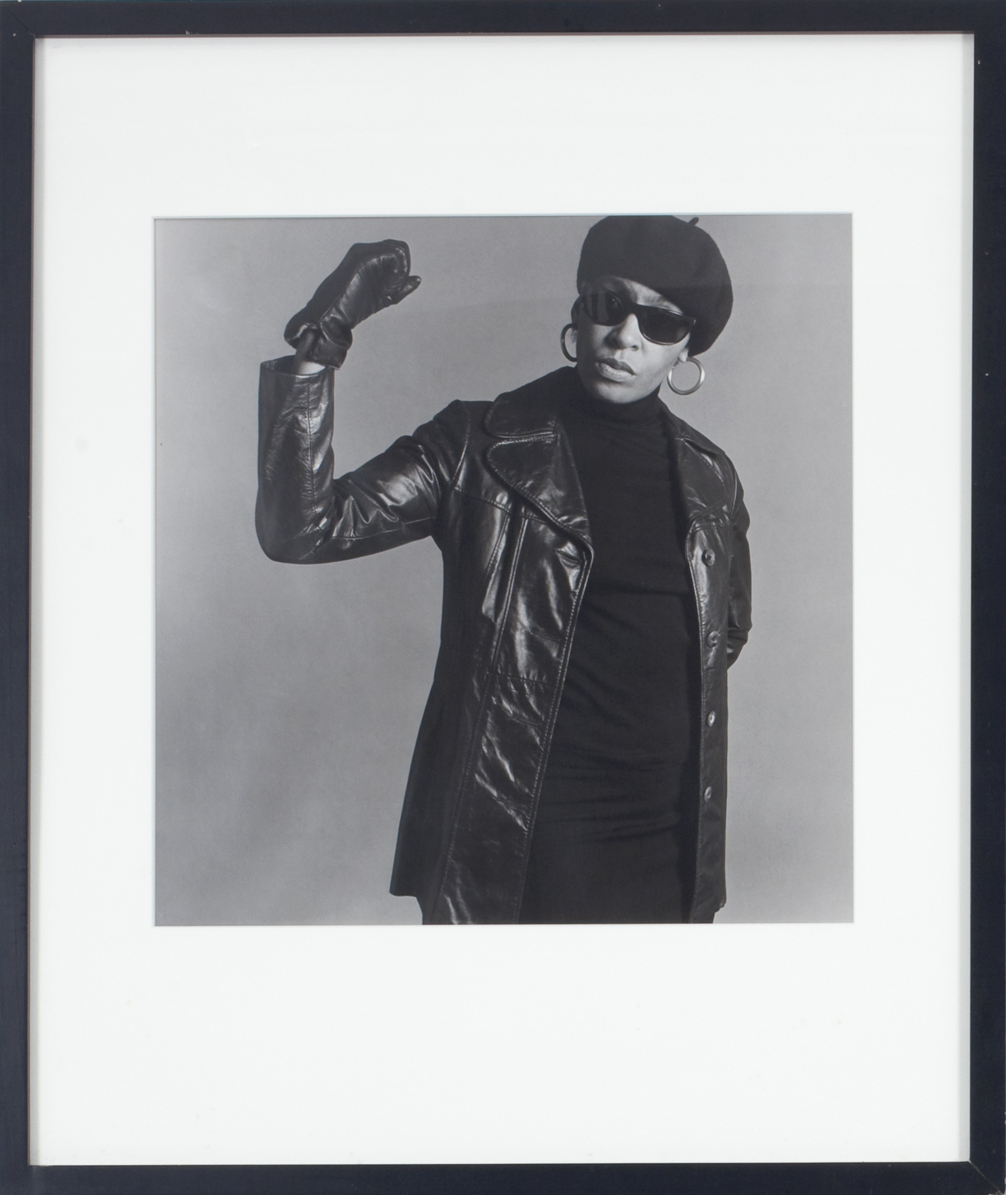
Fig. 3
Carrie Mae Weems
« Elaine, » from the series Four Women, 1988
Sepia-toned gelatin silver print, 20 x 16 in.
Courtesy of the artist and Jack Shainman Gallery, New York. »
Nevertheless, there are valid reasons for retaining the terms of postmodernist art theory as an overall schema for the exhibition. On the most obvious level, the artistic forms themselves—photo/text works, installation, video/installation—may be considered as quintessentially postmodern. Of the many artists in Mistaken Identities, only one—Glenn Ligon—is a painter, but even here, the paintings are composed of texts, a form of literal quoting.
More suggestively, attempts to describe and define what at least one commentator wants to theorize as [British] “Black Art” are virtually indistinguishable from the terms others have used to designate postmodern art practices tout court. Thus, in his essay “The Congo is Flooding the Acropolis: Black Art, Orders of Difference,Textiles,” Sarat Maharaj argues that one of the distinguishing features of the art he discusses resides in its playing off the codes of the dominant culture:
The drive behind [Black Art’s] oppositional mode seems to be the desire to find some stance outside the prevailing system of representation from which to impeach and castigate it, from which to overturn and transform its way of picturing self and other. But such an outside standpoint, it would appear, is not so much found ready-made “out there” as it has to be painfully constructed from within. It has to be forged, quite paradoxically, from the “inside” out of elements of the very system of representation it seeks to go beyond…. It is as if Black Art creates its critique through an initial complicity with the material it denounces, carves out its sense of critical distance by first becoming one with what it intends to keep at arm’s length. 6
Maharaj’s characterization of what he terms « Black Art » is in fact a restatement of postmodernism’s quotational strategies, derived either from mass media or other dominant representational systems. That these tactics should be invoked in the service of conceptualizing a distinctive « Black Art » seems curious, particularly in that the artists he discusses, like the artists of color in this exhibition, do not appear to be working in ways (themes and subject matter notwithstanding) markedly different from those of their peers. On the contrary, if artists of color can legitimately be discussed apart from other artists situated within the cultural space of postmodernism, it is with respect to their willingness to address problems of identity and subjectivity while acknowledging the limits and possibilities of postmodernism’s analysis of material and institutional power.
But in characterizing the art of Mistaken Identities under the sign of postmodernism, I am thinking less of the now-familiar tropes and strategies of postmodernist artmaking (e.g., appropriation, pastiche, engagement with mass cultural forms—although these can certainly be found in much of this work) than I am of postmodernism’s concern with the politics of representation. Clearly the issue of representational politics has particular urgency in the case of those who have historically been denied the means of self-representation, encapsulated in Marx’s description of the colonized « Who do not represent themselves, [but] are represented. »

Fig.4
Carrie Mae Weems
Black Woman with Chicken,1987
Gelatin silver print, 20 x 16 in. Courtesy of the artist and Jack Shainman Gallery, New York.
In this sense, Carrie Mae Weems’ photographic reiteration of the most obscene and degrading stereotypes of black men and women, as in her Jokes series or, for that matter, in her Black Man with Watermelon and Black Woman with Chicken (fig. 4), are especially interesting. Such works are uncompromisingly confrontational and deeply uncomfortable, as provocative and unpalatable to certain white viewers as to black. 7 Which is not to say that the scandal of, for example, What are three things you can’t give to a black person? functions in the same way for black and non—black viewers. In reproducing the racist stereotype, albeit in deliberately aestheticized form, Weems is doing something akin to the earlier work of Cindy Sherman, who likewise trafficked in the purveyal of stereotypes—in Sherman’s case, a lexicon of femininity. In Weems’ Four Women (fig. 3), the analogy is even closer, as Weems herself stages the roles of, for example, black militant, African nationalist, and bourgeois housewife. But the act of reiteration, the re-presentation of the racist stereotype, partakes as well in the strategy of mimicry, a strategy that has been theorized as itself a form of subaltern resistance. 8 The appropriation of the stereotype and the strategic use of mimicry have in fact been characterized as distinctive modes of African-American “signifying”—a hybrid mode of cultural resistance and survival. 9 This deployment of the already-known, already—seen (no matter how distasteful or piously disavowed) is also a hallmark of postmodernist practice. And while Weems brings to her work the knowledge and perceptions of a trained folklorist, the programmatic and artful repetition of the racist stereotype is equally a quotational device consistent with the tropes of postmodernism. It is significant too that Weems—like all the artists in this exhibition—rejects the notion of what might be called representational reparations, that is, the countering of degrading and racist imagery with “real” or “true” or “positive” depictions of black people. Although it would be possible to claim that the haunting beauty of the model in Black Woman with Chicken and the emotional power of her gaze constitutes such a corrective, for the most part Weems operates uncompromisingly in the realm of the stereotype. Here again, the deployment of the stereotype in ways that render its malignant operations critically visible has been a staple of postmodernist art, going back at least to Sherrie Levine’s and Richard Prince’s work of the late 1970s.
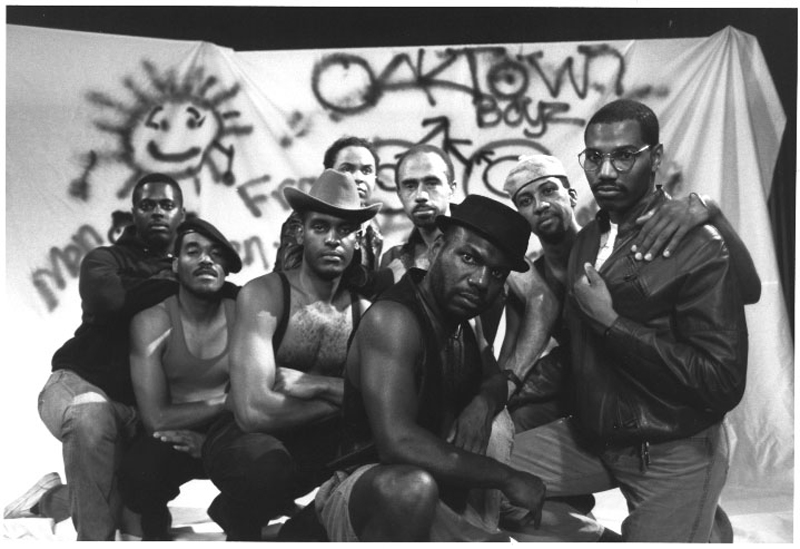
Fig. 5
Marlon Riggs
video still from Tongues United, 1989
Videotape, 55min.
Courtesy of Signifyin’ Work, © Marlon Riggs
Where Weems brackets identity behind the glass darkly of the stereotype, Marlon Riggs’ Tongues Untied approaches identity (in this instance, black, gay male identity) from the opposite direction, that is to say, Within an affirmative and collective act of self-naming (fig. 5). Tongues Untied demonstrates the political strategy of affirming a socially demonized identity for emancipatory ends. The recurring banner—“Black men loving black men is the revolutionary act”— thus equates sexual preference with political struggle. In taking the identity “gay black male” as a given, and celebrating its erotic and discursive expression, Riggs’ film is concerned less with the construction of that identity than with its defiant transgression of dominant (and oppressive) notions of masculinity, black or White. In this respect, Tongues Untied differs somewhat from most of the work in this exhibition. But insofar as it demonstrates an artistic strategy of empowerment through self—naming as well as other means, it reminds us that collective identity politics (represented, for example, in the film’s depiction of street politics and demonstrations) is a powerful motor of political struggle. Thus, where Weems can be said to consider subjectivity and identity from the perspective of subjection, Riggs celebrates the manifestations of agency. These twin facets of identity—the subject as subjected and the subject as agent—marl< the limits and possibilities of subjectivity, and it is the tension between the two, evident in much of this exhibition, that complicates a too facile opposition between “identity politics” and social constructivism.
What primarily separates the works of artists like Weems and Riggs from those generally grouped in the category of critical or oppositional postmodernism is their recognition of the specificity of issues of identity and subjectivity as they are experienced by people of color and other subaltern groups. This, too, is shaped by multiculturalist and postmodernist theories, both of which have prompted artists to reclaim subjectivity as an object for aesthetic exploration. This subjectivity, however, resembles little its modernist ancestor, because the subjectivity investigated is apprehended historically and politically as well as psychologically. It is not the generic, transcendental Artist who speaks, but the singular, historical one. Similarly, this insistence on specificity enables these artists to grasp metaphorical formulations—for example, the invisibility of the woman of color—and give them concrete embodiment.
However, in organizing Mistaken Identities with cognizance of the complexity and diversity of the arguments—theoretical, political and practical—around identity and multiculturalism, the idea was less to produce a coherent and unified position than to assemble works that are variously engaged with what could be termed the problematics of identity. We were interested in art practices that are either concerned to demonstrate the psychic and/or social components by which diverse identities are attributed or fantasmatically projected (cf., Williams, Rosler, Kelly, Hatch, Tabrizian and Golding, Weems); that suggested the provisional, bricolage—like formation of identity (cf., Durham, Gómez-Peña, Hak Kyung Cha, Rascon, Yong Soon Min); or those that dismantled or deconstructed the putative fixities of race and racialism (cf., Ligon, Piper).
The identities collectively explored in this exhibition are thus “mistaken” insofar as they have ever been imagined or conceived as one thing, whether that thing was identified as race, gender, or ethnicity. This range of artists and diversity of practices demonstrate that the multiple and shifting field of identity in its subjective and experiential reality is embedded in history, in discourse, in context, and is thus never a simple and unproblematic given. Assembling a group of artists whose common denominator is the rejection of what I have termed representational reparation (unless one considers the imaging of what has been overwhelmingly obscured as itself a form of reparation), the intention is to shift the burden of reparation from the artist to the curator, the critic, the institution. In this respect, the marginalization of the art world’s “others” has been no less a consequence of the myopia of critics, myself included, who while defining themselves as feminists, and proponents of an oppositional postmodernism, were nonetheless blind to the claims of those very differences our critical apparatus ritualistically invoked. This systematic, if unwitting practice of omission and exclusion demonstrates as clearly as anything where the burden of reparation must fall. Furthermore, any engagement with the issues raised around multiculturalism and identity in the visual arts reminds us that the “political” is by no means a circumscribed property of those artists who would openly claim it as a foundation of their artmaking, but even more fundamentally, is an inescapable condition of our activities in the institutional and discursive spaces of culture.
With this as the theoretical underpinning, the shaping of the exhibition was predicated on a politics of form. The absence of traditional media, figurative painting, or “realist” modes of expression is thus quite deliberate. 10 Furthermore, almost every work in the exhibition features the use of text. While this presents real problems in an exhibition destined for non-Anglophone venues, the ubiquity of textual use or citation is not only a legacy of conceptualism, but a feature of the artists’ collective awareness that race, gender, and ethnicity are entities produced and reproduced within language.
As with conceptualism, the artists in Mistaken Identities confirm that art functions on many levels beyond the “purely visual,” that its meanings and address are always and already implicated in this “other scene” of representation, and lastly, that issues of subjectivity (the artist’s or the viewer’s) are inseparable from the linguistic structures that forge this subjectivity.

Fig. 6
Adrian Piper
My Calling (Card) #1, 1986
Commercial printing on paper, 2 x 3,5 in.
Collection or the Museum of Contemporary Art Chicago
Courtesy of APRA Foundation Berlin © Adrian Piper Research Archive Foundation Berlin
But the agency of language in so much of the work in Mistaken Identities—particularly that produced by artists of color—has a quite specific aspect, signaling the ways in which linguistic use (including the act of naming) produces and reproduces the material and the institutional structures of racism, xenophobia, class, and gender that are part of the perception of difference. To take two highly contrasting examples, consider the deadpan politesse of the text used in Adrian Piper’s My Calling (Card) #1 (fig. 6). In a precise and pointed way, it informs the recipient that they have made a racist remark in the mistaken belief that their interlocutor was white. It could be said that the “work” is itself a work of language, but it is more accurately described as a work of social interaction, since its import is ultimately located in its effect on the recipient. Nonetheless, it is language that carries the art, and language in its most de-aestheticized, plainspoken form. The wit of the title, which identifies purposeful anti-racism as a type of vocation, evokes as well another, older meaning of a calling card. A statement of (bourgeois) identity that is as personal as a name but as broadly social as a class, the traditional calling card—not to be confused with the modern business card—announces the bearer’s existence, social visibility, and worldly position. Orlando Patterson’s characterization of slave status as “social death” suggests the profundity of Piper’s response. 11 Countering racism with a token of gentility, the calling card format is simultaneously both demure and explosive. In this respect, Piper has written eloquently on the moral logic of etiquette:
Norms of etiquette govern interpersonal treatment of individuals. Unlike many other kinds of norms, they function (or fail to function) independently of class and economic status. Norms of etiquette that express acceptance of cultural and ethnic others include norms of courtesy (which exclude racist or sexist slurs), of noblesse oblige (which exclude self-serving contempt for or indifference to the less fortunate), of modesty and humility (about who is in fact less fortunate than whom, and in what respects), of tact (which presuppose sensitivity to others’ feelings irrespective of cultural or ethnic affiliation), and a sense of honor (which includes extending to others the same respectful treatment one expects for oneself). judged against these norms, racism and sexism are not only unjust and immoral. They are also boorish and tasteless; and those who practice them overtly in any context betray vulgarity and inferior breeding.12
Unlike Piper’s instrumental and direct address, language in Ligon’s work is consistently literary. The citations (the writers he has used include James Baldwin, Zora Neale Hurston, Mary Wollstonecraft, and Jean Genet) speak variously of race and identity. But in most of Ligon’s works the textual citation is the very stuff of the paintings; writing is used as painterly sign as well as the vehicle of content. In much the way that Mary Kelly’s Interim (in its entirety) manifests a complex and critical relationship to her conceptual and minimalist predecessors, Ligon’s text paintings enact a critical dialogue with late modernist abstraction. Nowhere is this relationship clearer than in Baldwin #4, an acrylic on paper work which, when covered with plexiglas, appears on first sight to be an undifferentiated black ground or, as one approaches, a subtle variation of black-on-black, evoking, for example, the famous black paintings of Ad Reinhardt. In fact, like Ligon’s previous work, Baldwin #4 is equally a painting of a text and a text as painting, or a painting as text.
At least implicitly, Baldwin #4 offers a critical commentary on the pretensions of ’50s abstraction. For despite their strenuous aspirations to sublimity, universalism, and transcendence, the paintings of artists such as Barnett Newman and Ad Reinhardt have been historically revealed to be as contingent and contextually bound as any other “period” style. In this respect, Ligon conscripts what seems like a paradigmatic high-modernist form—a black on black painting—to radically different ends. For example, the Plexiglas covering, which obscures the text, is also a reflective surface; as the viewer deciphers the text, the work insistently mirrors her own reflection. Modernism’s concern with self—reflexivity is here given a particular spin, turned—détourné—back upon the viewer, whose identity is simultaneously inscribed in the work.
Insofar as Baldwin #4 is the bearer of a quotation, it also refutes the notion of immanent or transcendent meaning. In the quoted passage, excerpted from James Baldwin’s 1976 The Devil Finds Work (see the opening page of this essay), Baldwin conceives identity as something extrinsic—even provisional—rather than intrinsic to an innate and authentic self. Beneath this contingent “garment,” like a nested egg, a prior and anterior selfhood may (or so it is implied) assume other identities, other avatars.
Almost two decades from its composition, Baldwin’s lyric statement is charged with great poignancy, for it is an open question as to whether blacks in America are permitted so easily to “change robes,” to forget, even momentarily, the mark of color. As Drucilla Cornell reports, a recent study has shown that “within the first seconds of an encounter, the viewed person is identified first by ‘race’ and then by ‘sex’.” 13 That Ligon makes of this utopian text a black painting, of a blackness, moreover, that almost submerges the text, suggests a counter-proposition, namely the overwhelming determinations of race in America.
That the content of Baldwin #4 is virtually invisible from any distance links it not only to other of Ligon’s works that interrogate the dyads of whiteness/blackness and color/whiteness, but to one of the most pervasive thematics in the cultural production of writers and artists of color, a thematic, moreover, that figures prominently in Mistaken Identities. As indicated in the title of Michele Wallace’s most recent book, Invisibility Blues, and searingly described at least as early as Ralph Ellison’s The Invisible Man (1952), the social, psychic, and political consequences of invisibility are an infected wound in the very fabric of American life, which must now be confronted. To the belated and inculpating recognition that non-white Americans are in complex and mutually reinforcing ways rendered invisible within the spurious myth of the U.S. as a homogeneous, white, Anglo-Saxon culture, must be added the corollary acknowledgment that the invisibility of the black American has a particular and lethal aetiology. On the one hand, the mark of racial “blackness” operates to ratify the symbolic meanings of the word, with all its negative connotations of darkness, obscurity, and so forth. But on the other hand, there is a way that the mark of blackness functions to confer—nowhere more damagingly than in the perception of the young black man—a kind of hyper-visibility; he thus becomes a veritable totem of menace, the very embodiment of violence and unlawful sexuality. 14
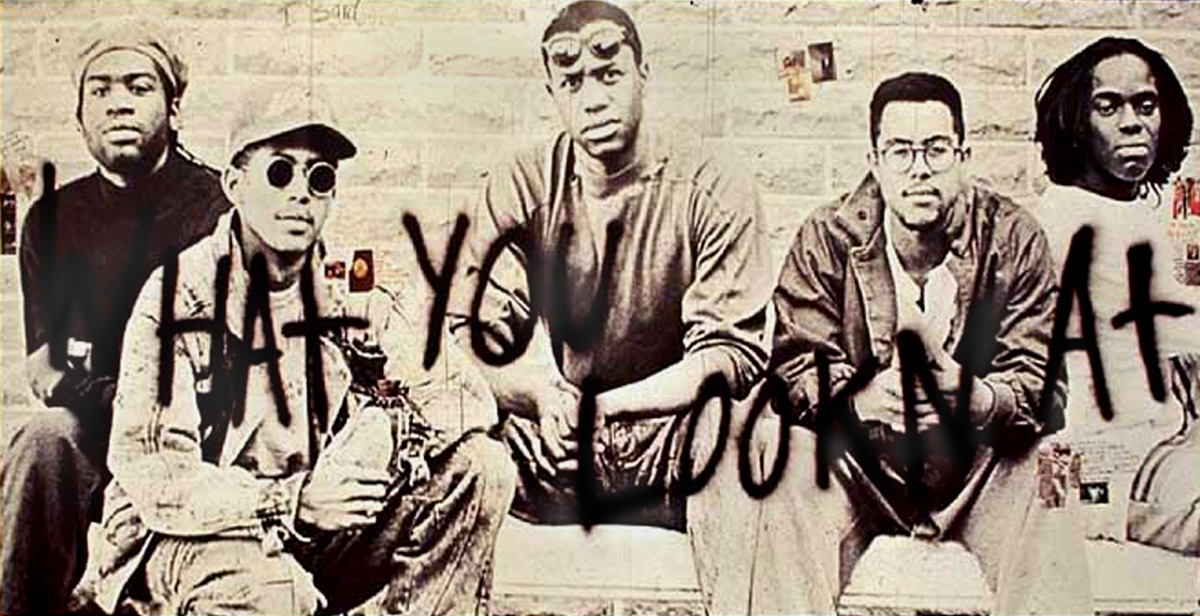
Fig.8
Pat Ward Williams
What you lookn at?, 1992
Mixed media on photostat
Courtesy of the artist. © Pat Ward Williams
Pat Ward Williams’ What you lookn at? speaks directly to this contradictory condition. Originally created for installation in the gallery windows of the Goldie Paley Gallery (Moore College of Art and Design) and similarly installed in the window of the University Art Museum, Santa Barbara, this photo-text mural confronts the passerby with life-size images of five young black men, frontally posed and looking directly out to the street. Although nothing about them objectively denotes any particular threat, the work is predicated on the notion that the mere sight of such youths is, for many people, disturbing and frightening. 15 The graffiti-type legend— »What you lookn at? »—in its argotic spelling as well as its crude lettering—battens on the signifieds of graffiti itself as it is often perceived by urban residents (e.g., the decay of the city, disrespect for property, anarchic and violent youth, etc.). But the interrogative “What you lookn at?” is, of course, hardly a neutral question. It is a challenge, a confrontation, a reproach. What you are looking at is in fact a menace as much fantasmatic as real. It is a collective bogey, variously comprising disavowal (a refusal of individual as well as political responsibility for the social production of criminality and violence); projection (individual and collective fantasies about what black men are); and anger and resentment (as people experience less and less control over the circumstances of their lives they tend to project their rage and anxiety on the scapegoated other).
Engaging this dense structure of projection and fantasy, Williams has manipulated her photographic image in such a way that as one approaches the surface, the figures lose resolution, decomposing into component particles. This dissolution has perhaps a utopian dimension; it is as though a closer confrontation with these racial phantoms reveals the viewer’s own projective collusion. As Adrian Piper has remarked, “racism is a visual pathology,” and one of the most compelling features of What youlookn at? is that it transforms the visceral, immediate trigger of racist response into a cautionary lesson, a heuristic brake on habitual and thus often unconscious forms of perception.
Furthermore, that What you lookn at? was designed for display in a gallery or museum window prompts another level of meaning, insofar as the window is normally the most “public” space of the museum, dividing the sanctum of elite culture from the heterogeneity of the street. Occupying this liminal space, the image of young black men “addressed” to passersby suggests that their excessive visibility—a visibility which has nonetheless nothing to do with mutual recognition or affective reciprocity—is the principal form in which black (male) youth achieves public recognition.
In contrast to the ominous hypervisibility of young black men, much of Lorna Simpson’s work has been preoccupied with, if not predicated on, the discursive invisibility of black women. While it is true, as Michele Wallace has argued, that in contemporary American culture black women may also be the object of a heightened (and intensely fetishized) visibility, as in certain segments of the entertainment or music industry, this visibility exists for the most part within the presiding terms of spectacle. The highly mediated “presence” of a few black Women performers is by no means a corrective, or even an equalizer of the non-place to which most women of color have been historically relegated. This is an invisibility that greatly exceeds the boundaries of metaphor, encompassing as it does the erasure of black women from history, indeed, from American culture itself—the occulting of black female subjectivity across the board, even including black women’s invisibility within oppositional and liberation movements (e.g., civil rights, Black power, feminism, etc.).

Fig.9
Lorna Simpson
Dividing Lines, 1989
Two color polaroïds with 8 plastic plaques
Courtesy of the artist. © Lorna Simpson
Simpson’s generic black woman, despite the shift in her meaning and function from work to work, always commemorates this historical and discursive repression. Headless, faceless, or turned away from the spectator, she simultaneously enacts her effacement while instituting her presence. While this refusal to fully deliver the image of the woman to the viewer bears certain resemblances to the feminist iconoclasm of Mary Kelly, it also plays a distinctive role within Simpson’s work as a whole. Like her use of elliptical and fragmentary words and phrases whose meanings and associations must be given significance by the viewer, this fragmented and effaced black woman is a generator of meaning(s), not a stable receptacle for them. 16
Simpson’s faceless woman is, in fact, a kind of visual cipher. Whether young or middle-aged, pretty or plain, in the decontextualized space of the seamless back-drop she is merely a graphic assertion of black femaleness. Hence, it is the work of language to quicken and animate this static marker of racial and sexual difference. In a work such as Dividing Lines (fig. 9), a selection of myriad applications of the word “lines” suffices to mobilize the image, galvanizing a set of meanings that range from the economic (“line one’s pocket,” “red lining”—e.g., the banking practice of refusing mortgages in low income neighborhoods); to the transgressive (“out of line,” “line up”); to the mendaciousness of language (“same ol’ line”); ending with the unambiguously racial “color line.”
Simpson’s linguistic plays, no matter how polysemic or deliberately ambiguous, are always played off against the enigmatic presence/absence of her black model. The viewer is therefore enjoined to reflect upon the possible relations between an anonymous woman of color—a body, as in “any body”—and the-political, social, and often sexual associations of her texts. And despite the handsome, graphic, even seductive presentation of her works, the tantalizing refusal to proffer the woman to the viewer’s gaze may be thought of as yet another stratagem of response to Piper?s “racism is a visual pathology.”

Fig.10a-b
Mary Kelly, Menacé (one of three diptychs)
from Corpus, 1984-1985
Part I of the project Interim, 1984-9
Laminated photo positive, silkscreen, and acrylic on Plexiglas, 6 panels, each 48 x 36,5 x 2 in.
© Mary Kelly
To the extent, moreover, that Simpson’s work engages gender as often as race, it must be acknowledged that the representation of femininity, black and white, is inescapably moored in dynamics of fetishism, voyeurism and (male) fantasies of mastery, possession, and imaginary knowledge. Pathologies of the visual are by no means limited to the operations of racism. Insofar as women may be said to constitute a subaltern group within patriarchy,- and insofar as issues of visibility/invisibility impact in quite specific ways on feminine identity, Mary Kelly’s Corpus (fig. 10a—b) resonates in interesting ways with Simpson’s work. The inclusion of an excerpt from Kelly’s Interim is thus consistent with the themes of the exhibition as a whole. Whereas the monumental Interim in its entirety investigates the problematic identity of the aging white, middle-class woman, paralleled by the historical fortunes of modern feminism, both of which are indexed » to the social and economic status of women, Corpus is the section most concerned with the problematics of visibility. A woman’s experience of aging is here understood as deeply implicated in such problematics, since one of the aporias of femininity lies in the eclipse of visibility as women pass beyond the age of reproductive capability and are inexorably moved toward the (culturally imposed) sexual limbo of old age.
But where one oppressive aspect of feminine identity is constructed through various forms of invisibility (encoded, for example, in linguistic usage such as “mankind”), others are bred precisely through an excessive emphasis on the visual (although differently inflected from the way this functions in the case of young black men). 17 Nineteenth—century medical science, for example, professed to read the signs of mental and physical inferiority visually from the appearance or the morphology of women. In this regard, Kelly’s Corpus makes pointed reference to the late nineteenth-century French discourse of hysteria. Codified by Dr. Jean Martin Charcot and quite literally enacted by the incarcerated women at the Parisian hospital of Salpétriere, hysteria was preeminently a visual, not to say spectacular malady.
In evoking hysteria’s putative phases and “events,” (the attitudes passionelles), Kelly mobilizes but one of her historical motifs. Orchestrated too within Corpus is a handwritten fiction of contemporary white feminine subjectivity, consisting of reveries, daily incidents, reflections, and anxieties, many of which revolve around the more or less subtle experiences that constitute the perception of aging. These text panels are themselves counterpointed with images of apparel—shoes, leather jacket, nightgown—photographically reproduced in such a way as to appear simultaneously concrete and illusionistic, material and spectral. Participating in both the (a)logic of the commodity and the psychic fetish, and lastly, as a metonym for the body itself, Corpus reminds us that the conditions and constraints of feminine identity, like all others, are generated fully as much by the social and political as by the psychic.
Fig 11a-c
Mitra Tabrizian and Andy Golding, The Blues, 1986-87
Third of three triptychs
Cibachrome photographs, each panel 49 x 66 in.
© Mitra Tabrizian and Andy Golding

© Mitra Tabrizian and Andy Golding
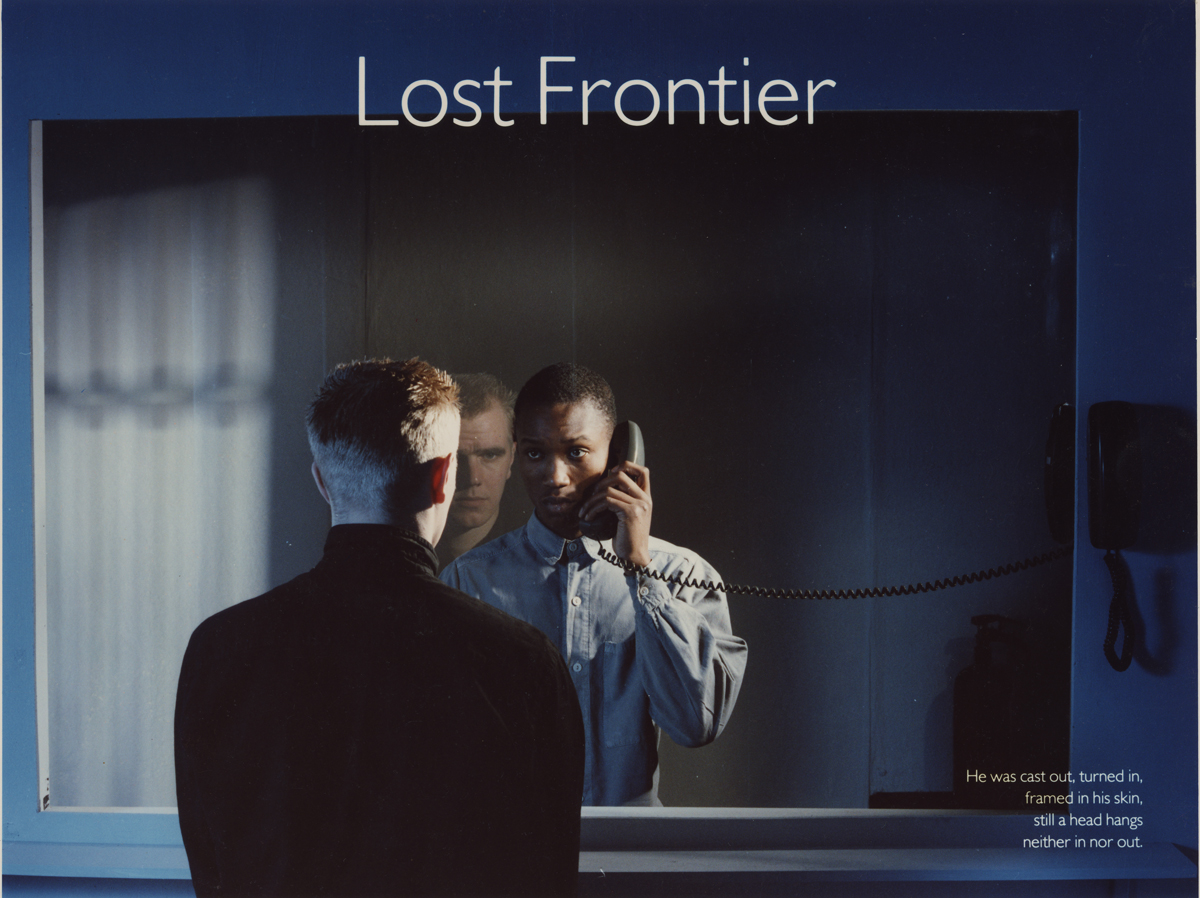
© Mitra Tabrizian and Andy Golding
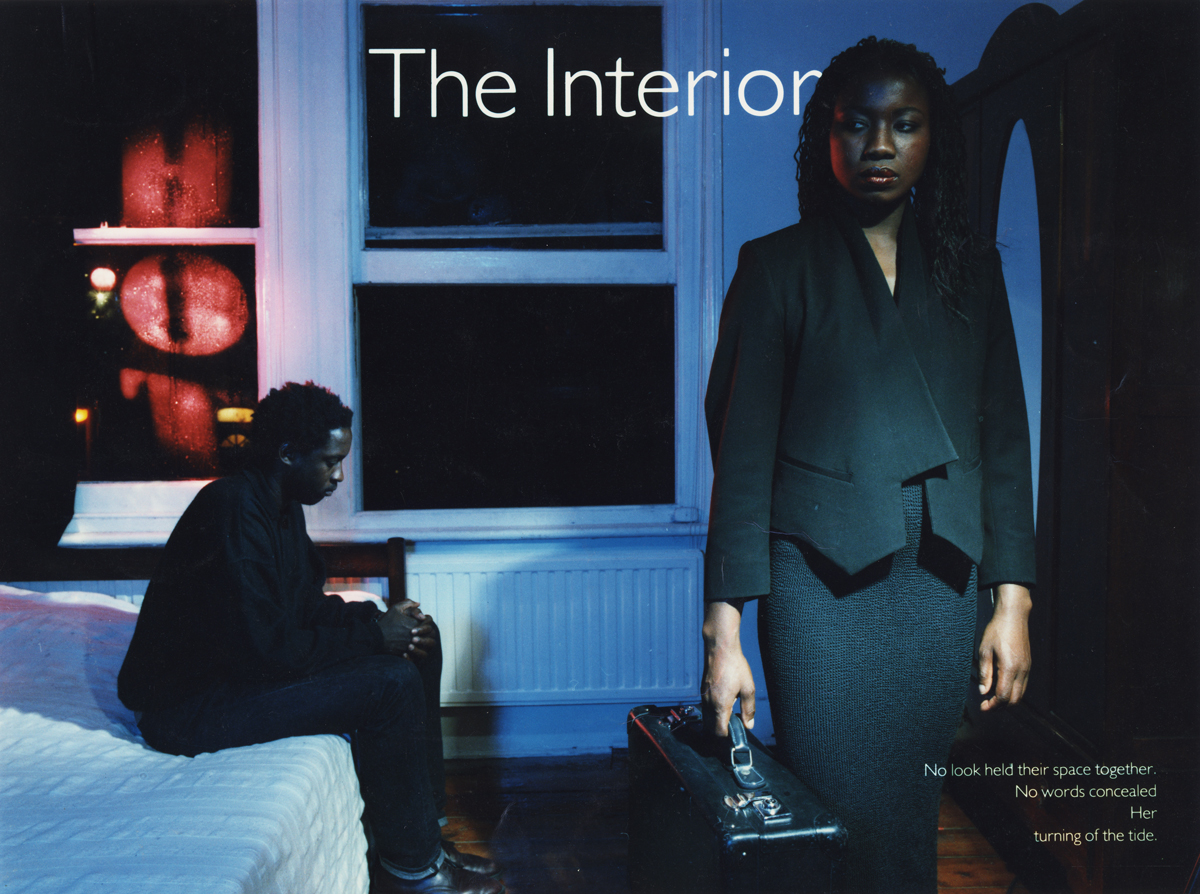
© Mitra Tabrizian and Andy Golding
The attempt to encompass all three of these fields of identity as they constitute the “alchemy” of race 18 also structures the three triptychs that make up Mitra Tabrizian and Andy Golding’s The Blues (fig. 11a—c). A collaboration between a London-based Iranian woman and an English man, this is the only work by non-American artists in the exhibition. Created between the years 1986-1987, The Blues is especially significant as a work exploring the intersections of race and gender. That The Blues was produced as a collaboration between non-black artists is itself significant. 19 Years ago, I remember seeing Tabrizian present this work at a talk she gave in New York City, where she was angrily challenged by a member of the audience for presuming, as a white woman, to “psychoanalyze” representations of black people. Her immediate response—“Racism is a problem for white people”—is actually an informing principle of this work, which turns on the intrasubjective mechanisms of race and racism, gender and sexuality.
Like much of the art in this exhibition, The Blues does not lend itself to capsule summary or thumbnail exegesis. With its titular allusion to melancholy and to a distinctive form of black culture, The Blues also draws on conventions of cinema (e.g., film noir—itself a pun); high art (e.g., the image labelled The Interior is a reworking of Degas’ The Interior, also known as The Rape); and hard-boiled detective novels. Staged as a series of tableaux vivants, images and texts combine to solicit the viewer’s fantasies about the “role” of black men and women within scenarios suggestive of murder or suicide, aggression, political confrontation, abjection. Often, the black protagonists are the psychological and physical locus of the gaze of white men. Alternatively, white men are presented as aggressively threatening or twinned with the black men. In one tableau, the black woman appears as an active agent (thereby reversing the role of the passive woman in the Degas); in another, she is dead; a third features a masked white woman, looming above the seated, white-masked black. The implied narrative or the role of the women in The Blues signals the complicated (and often repressed) role of gender within the matrices of race, masculinity, and interracial relations between men.Whose stories, we may ask, are these? In fact, and for all its density of reference to mass-cultural forms, The Blues is constructed along lines analogous to Freudian dreamwork, deploying strategies of displacement, condensation, and considerations of representability (hence, the punning use of language). 20 The use of mirrors, windows, and reflective surfaces further insinuates the psychic, interiorized space in which the confrontations of self and other are staged and invested with meaning.
Implicit in the psychoanalytically informed work of Kelly and of Tabrizian and Golding is the conviction that the formation of individual identity, as well as beliefs about the other’s identity, are jointly forged by unconscious processes that are more or less inaccessible to logic, reason, or empirical revision. This immediately raises the political question of how art practices that are obviously committed to an analysis of sexism and racism, and thus motivated by political concerns, are to act upon—to transform—entrenched attitudes and beliefs. It remains, of course, unresolved for all critical and political art practices (particularly those that exist within the confines of elite culture) as to how to effect their desired interventions and transformations. To the degree that art objects, even the most rigorously conceptual, operate to mobilize non-rational, pre-conscious and unconscious responses in both artist and spectator, one could argue that it is precisely along the lines of the psychic and fantasmatic that critical art practice operates most potently. The more purely political valencies of identity may, however, require their own forms of analysis; thus, while some artists in Mistaken Identities construct their work to mobilize relatively fluid associative trains, others, like Connie Hatch, are closer to the tradition of heuristic political art exemplified by artists like Hans Haacke and Krzysztof Wodiczko.
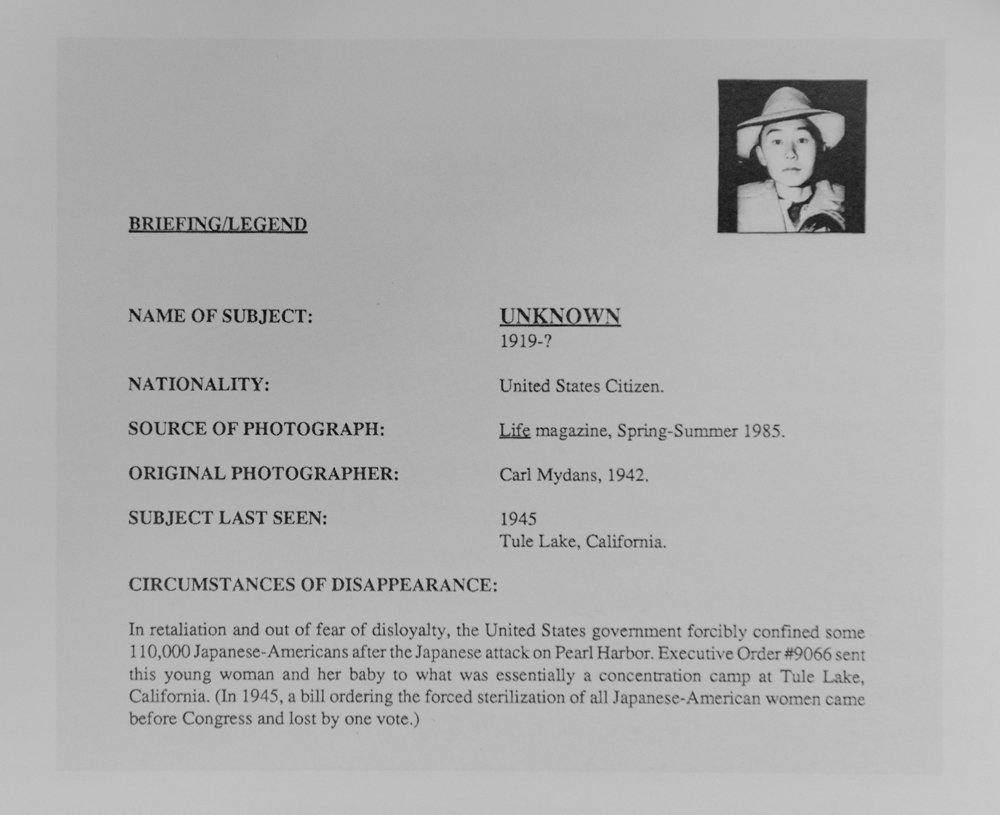
Fig. 12a
Connie Hatch
briefing sheet for « Unknown Woman » from Some Americans: Forced to Disappear, 1990-91
© Connie Hatch
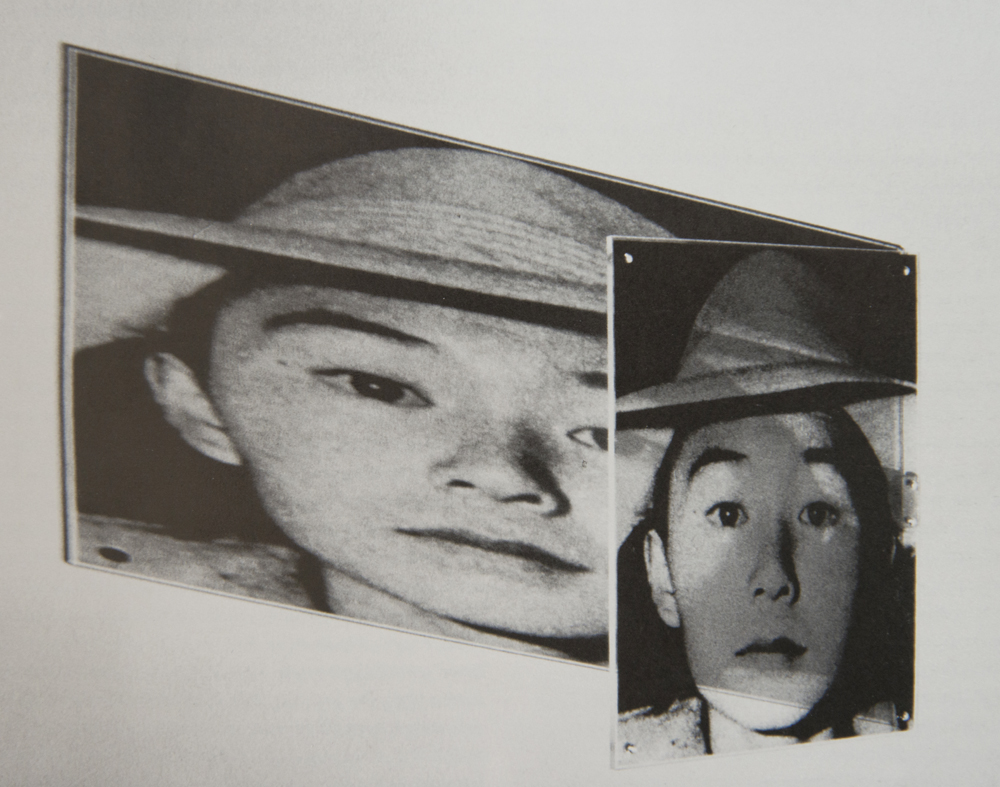
Fig. 12b
Connie Hatch
« Unknown Woman » from Some Americans: Forced to Disappear, 1990-91
© Connie Hatch
In Hatch’s Some Americans: Forced to Disappear (fig. 12a—b), derived from the larger project entitled. A Display of Visual Inequity, the structuring terms of visibility/ invisibility are again at issue. Hatch is here concerned with the circumstances and determinations by which some individuals are “recognized” (literally, by the spectator, and more generally, by the culture at large) and others relegated to obscurity and anonymity. All of the American women (and the one man) whose portraits are mounted on the wall have disappeared—died—under known or unknown circumstances. “Identity” is approached in this work as a fully social and indeed political production, one that achieves maximum visibility in the case of a famous movie star, such as Marilyn Monroe, and maximum invisibility in the case of victims of official, or merely arbitrary violence (e.g., the unknown Japanese-American woman “last seen” when interned in the U.S. detention camp during World War II; the “disappeared” child whose image comes from the reverse side of a carpet cleaning advertisement; the Argentine woman “disappeared” during the counter-insurgency operations of the Argentine junta). Confronted with the wall of portraits mounted and lit in such a way as to produce a ghostly double on the surface of the wall, the spectator normally recognizes some, but not most of the faces. On an adjacent wall, however, Hatch affixes what she calls briefing sheets, which provide the identifying biographical information and the circumstances (when known) of the subject’s disappearance. Written in a style that mimics the source of her information (news magazines, popular biography, history books, etc.), the aggregate effect of the texts is to foster consideration of the political valencies of identity, whereby the brute fact of having been born female rather than male, black rather than white, Japanese-American in wartime America, and so forth, are in and of themselves determinations that override the particularities of individual identity.
The political components of identity are also the subject of Martha Rosler’s videotape, Vital Statistics of a Citizen, Simply Obtained (fig. 13), in which a female subject is clinically and dispassionately surveyed, weighed, measured, and stripped. Subject of and subject to a Panoptic state—by implication, all modern states—Rosler’s unnamed woman submits to a process that is a veritable allegorization of Michel Foucault’s analysis of the twinned alignments of knowledge and power. We are thus reminded that behind this nightmarish mapping and measuring of an individual body lies the real—life actuality of bureaucratic procedures, identity cards, passports,hospital records, all the appurtenances by which the body is known and recorded, becoming thereby a subjected body. That this subject is female has an additional set of connotations, signalledas well in Kelly’s work. At least since the nineteenth century, it has been the female body that most provokes the gaze of knowledge/power, the body that excites what Foucault called “the frenzy of the visible.” Accordingly, Rosler emphasizes that the measuring and mapping of the female body has specific meaning with respect to the ideological construction of femininity.
Insofar as identity can be viewed as an amalgam of both interior and exterior determinations, there is some temptation to ascribe the former to the realm of the psychic and the latter to the realm of the social. In fact, such distinctions are untenable. For example, the formation of sexual subjectivity is forged in infancy and early childhood, in the family, in the individual psyche. Nevertheless, the significance attributed to sexual difference is consequent upon the differential values accorded the biological fact of being male or female—values that are, moreover, determined by the symbolic order of patriarchy, which is a social form anterior to its individual psychic assimilation. Similarly, “race,” to the degree that it has any biological and scientifically valid status at all (and that is little enough), has meaning only by virtue of the social and political implications that accompany its ascription. Yet its significance, though thoroughly adventitious and primarily social, is nonetheless psychically assimilated, becoming, in racist cultures or contexts, as inescapable and devastating a fact of psychic life as it is of social life. Accordingly, race is both a chimera and a social reality, making it an especially intractable object for critical art practice. Furthermore, to the extent that racism may be quite unconscious, harbored even despite one’s moral and ethical convictions, art production that confronts it in its more covert incarnations must necessarily operate on several fronts.
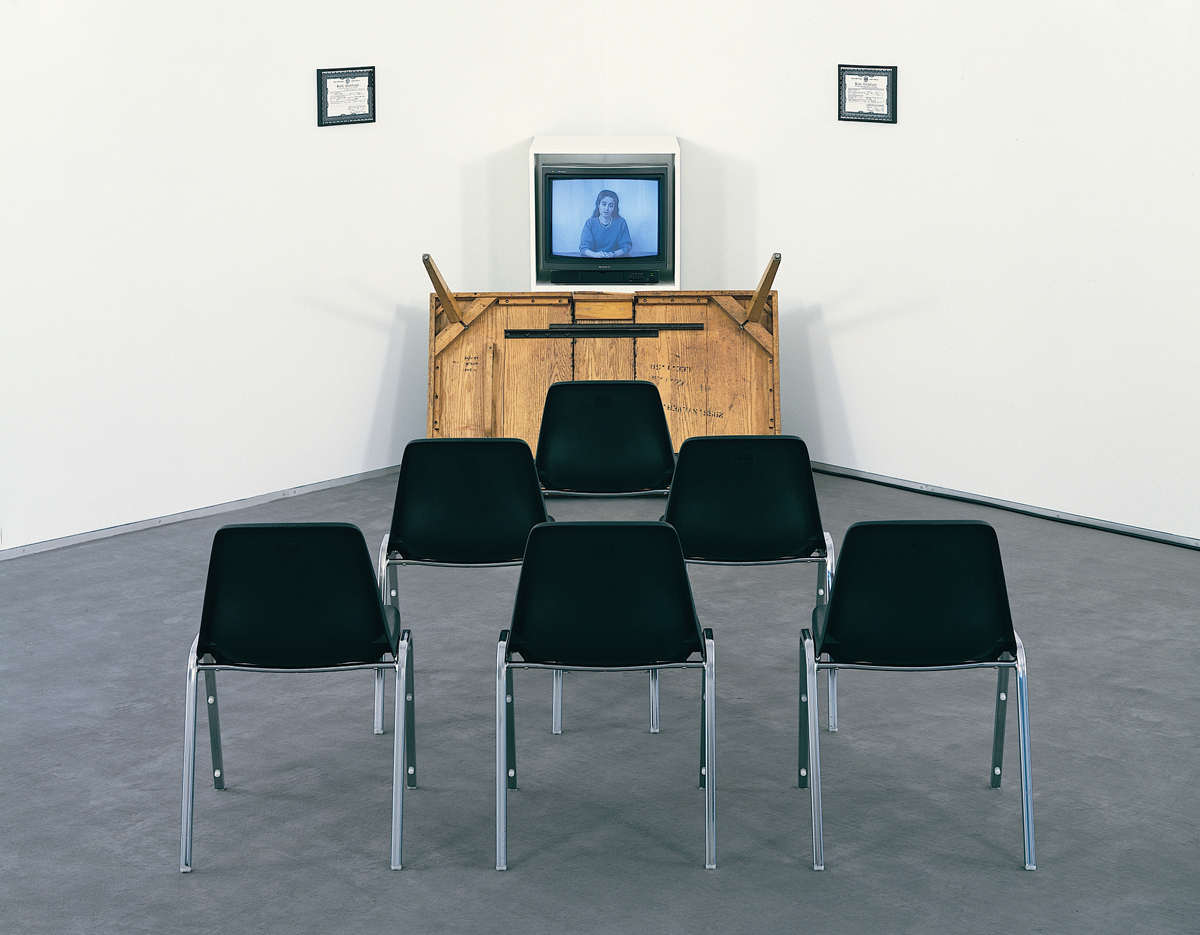
Fig. 14
Adrian Piper
Cornered, 1988
Installation view. Table, 10 chairs arranged in gunboat formation, television monitor, Adrian Piper’s father’s two framed birth certificates, lighting.
Collection or the Museum of Contemporary Art Chicago
Courtesy od APRA Foundation Berlin, © Adrian Piper Research Archive Foundation Berlin
In this respect, Adrian Piper’s videotape/installation Cornered (fig. 14) is an especially important work, provoking unacknowledged or unrecognized racism even as it performs an elegant deconstruction of the American cultural mythos of whiteness and blackness. A light-skinned black woman, often taken for white, Piper has addressed in several of her works—including My Calling (Card) #1 and the “confessional” Political Self-portrait #2—the singular state of racial in-betweenness. Installed in a corner, and barricaded by an up—ended table, the video consists of an ostensibly straightforward monologue by Piper. On the walls behind the monitor are mounted two birth certificates of Piper’s father, one giving his race as white, the other as black. Dressed and coiffed, as she describes it, in “bourgie, junior-miss style,” she begins with the announcement, “I’m black,” followed by the injunction, “Now, let’s deal with this social fact, and the fact of my stating it, together.” In the next 16 minutes, Piper proceeds to interrogate the various possible responses of the presumed white viewer to her statement, parsing out the racist implications of the viewer’s reactions. About midway through the monologue, Piper reports that “some researchers have estimated that almost all purportedly white Americans have between 5% and 20% black ancestry” and thus, according to entrenched racial conventions, are to be considered as black. The possible reactions to this information are then themselves pursued, culminating with the injunction that this shared black identity is not just Piper’s, but “our problem to solve…Now how do you propose we solve it? What are you going to do?” The tape closes with white letters on a black ground—“Welcome to the struggle.”
Although the word “miscegenation” is never uttered, one of the complex themes within the work is the repressed history of interracial sexual relations in American history, a history that is itself the legacy of slavery and its myriad violences. This too poses a question about the nature and terms of identity, for as Judith Wilson points out in her discussion of Political Self-portrait #2:
…while physical appearance is frequently the sole criterion for determining race in daily practice, U.S. law and custom define race as the product of genealogy—a highly variable predicator of physical traits as anyone who recalls Mendel’s “law of independent assortment” will readily grasp. In philosophical terms, the problem relates to the operation of consciousness. If identity is socially constructed and amounts to the assimilation of images of self reflected in the eyes of others, and if race is determined in practice by appearance and in principle by ancestry, what constitutes the “racial identity” of individuals whose a earance is at odds with their alleged ancestry? 21
This discursive instability at the heart of racial identity runs counter to assumptions underlying other discursive constructions of identity that posit its fixed and irreducible essence. In this regard, it is especially suggestive that recent writing on the subject by theorists such as Hortense Spillers focuses on the kind of “in-betweenness” that Piper explores in certain of her works. For example, in an extraordinary essay on the mulatta/o, Spillers elaborates what she terms the “neither/nor” status of a female subject whose very coloration, as well as its origin, disrupts the categorical distinctions upon which racial divisions are predicated:
Created to provide a middle ground of latitude between “black” and “white,” mulatto being a neither/nor proposition—inscribed in no historic locus or materiality—could therefore be only evasive and shadowy on the national landscape. To that extent, the mulatto/a embodied an alibi, an excuse for “other/otherness” that the dominant culture could not (cannot now either) appropriate or wish away… Behind the African-become-American stands the shadow, the insubstantial “double” that the culture dreamed in the place of that humanity transformed into its profoundest challenge and by the impositions of policy, its deepest “un-American” activity. 22
Such explorations of the “neither/nors” of racial, sexual, and cultural identities not only foster more complex, more nuanced perceptions of the multiple determinations of identity, but open up more fluid and supple political deployments of them. This is particularly evident in the range of theoretical and cultural production concerned with the notion of “borderlands” identities, that is to say, identities which, like Spillers’ neither/nor, are constituted precisely by the imbrication of the cultures of dominant and subaltern, oppressor and oppressed. This too is an alchemy of both individual and cultural identity, a syncretism that produces the hybridized forms of consciousness and identity that are both shaping elements of social formation in the U.S. and the very hallmark of postmodernity.

Fig. 15
Guillermo Gómez-Peña
Video still from Border Brujo (Shaman), 1990
Courtesy of La Pocha Nostra
Guillermo Gómez-Peña, whose Border Brujo [Shaman] (fig. 15) is included in the video portion of the exhibition, is associated both as an artist and as an incisive cultural theorist with the implications of borderlands culture and identity. Mexican-born, and a resident of the U.S. since 1978, Gómez-Peña’s art, like Piper’s, is grounded in the legacy of conceptualism and, also like hers, embraces a wide range of forms-—book art, poetry, and film, but perhaps most influentially, performance art (Border Brujo is actually a video version of a performance). In a recent statement in Art in America, Gómez-Peña sketched some of the conditions and possibilities of hybridization, noting in passing that in the U.S., the art world and the educational system are the major battlegrounds in the multiculturalism debate:
In the last 25 years [Third World] immigrants have changed the West, almost to the point where the West is no longer the West. Asia and Latin America live in the U.S. in the same way that North Africa lives in Europe. A storm has shattered all racial, economic and cultural parameters. The U.S. is no longer the heir of Western European culture. Instead, it is a bizarre laboratory in which all races and all continents are experimenting with identity, trying to find a new model of conviviality. In this process, very exciting kinds of hybrid identities and hybrid art forms are being created. Unfortunately, violence, misunderstanding and fear are also created.
Let us talk about three sources of cultural identity. One is imposed from above by the state. This kind of identity, generally speaking, is fictitious and responds to the agendas of the governments that enforce it. Then there is an identity which comes from below, from the traditions and memories of specific groups within a society. This identity often enters into conflict with the one from above. Generated at the grass-roots level, it is much more fluid and, because it is open to fusion and cultural negotiation, it is constantly changing. I would also propose a third model: that of hybrid and transitional identities, of multiple and hyphenated identities…These new models [of identity], which I call hybrids, are what truly interest me; they speak for the future of this country and the entire continent. Contemporary Chicano, African-American or Asian-American cultures are dynamic, open systems in constant transformation.23
Border Brujo is a kind of one-man theater of borderlands culture and identity in which Gómez-Peña assumes a variety of roles, scrambling cultural codes, signifiers, languages, and identities, enacting the truism that the “border” is, for all its diverse manifestations, a state of mind. Behind an altar-like table, laden, among other things, with religious paraphernalia, Gómez-Peña, variously inhabits the roles of ersatz shaman, urban cholo-punk, wetback, gringo, bandito, and so forth, deploying a full menu of languages, dialects, argots. Occasionally, his language is itself a non-sense, comprehensible neither to Anglophone nor Spanish speakers. The linguistic mystification of both types of spectators appears to be an integral part of Gómez-Peña’s artistic strategy, suggesting that no single language adequately encompasses, mirrors, or translates the protean and variegated elements that make up the borderlands. In Gómez-Peña’s Work, this concept of borderlands is by no means a discrete entity. More precisely, it is both a process and a condition, akin to what is called “the postmodern condition.” Neither euphoric nor dysphoric, Gómez-Peña’s borderlands represents a cultural conjunction productive of new subjectivities and identities, a diagnostic that exceeds its precision the often wooly notion of multiculturalism. It is, moreover, a formulation that explicitly acknowledges differences within:
United States Latino culture is not homogeneous. It includes a multiplicity of artistic and intellectual expressions both rural and urban, traditional and if experimental, marginal and dominant. These expressions differ from one another according to class, sex, nationality, ideology, geography, political context, degree of marginality or assimilation, and time spent in the U.S. California Chicanos and Nuyoricans inhabit different cultural landscapes. Even within Chicano culture a poet living in a rural community in New Mexico has very little in common with an urban cholo-punk from L.A. Right wing Cubanos from Miami are unconditional adversaries of leftist South American exiles. The cultural expressions of Central American and Mexican migrant workers differ drastically from those of the Latino intelligentsia in the universities, ad infimtum. 24
Confronting the cultural fact of borderlands diversity, including its divergent and often opposed internal political formulations, must obviously preclude any notion of a unitary, or even unified, identity politics. Nevertheless, the kind of discursive remapping of American culture that in the broadest sense describes Gómez-Peña’s artistic activity has potent political implications. Most importantly, it seeks to dissolve the fantasmatic belief in a white, Anglo-Saxon America distinct and apart from those “others” whose very co-presence is in fact the consequence of America’s own history. Conversely, it corrects the equally fantasmatic belief that subaltern cultures can preserve an atemporal and ahistorical purity or essence. What is to be worked with, what indeed remains to be worked through, is the far more difficult acceptance of multiplicity, diversity, and difference itself.
Gómez-Peña’s notion of a borderlands identity, an identity that by definition is plural, “impure,” and in constant flux has certain correspondences with the no less hybridized art of Jimmie Durham, a Cherokee. Durham, like Piper and Gómez-Peña, works in a broad range of media (installation, “performance, assemblage and carving, image/text works, poetry and critical writing). In much of Durham’s art, the model of identity appears most closely to approximate Claude Levi-Strauss’ concept of bricolage, whereby cultural identity, far from being a holistic, “authentic,” and integral given, is rather a syncretic, piecemeal, and aggregate affair, cobbled together from disparate, random, even antithetical elements. Formulated with respect to ostensibly traditional and “tribal” cultures (and thus an explicit critique of Western romantic notions of authentic cultural or ethnic identity—products themselves of the Western imaginary), the concept has nonetheless a descriptive relevance in other contexts.
In Durham’s work, the political context is, of course, the morass of contradiction, historical crime and its disavowal, potent cultural mythologies, expropriation and immiseration that collectively constitute the circumstances of Native American peoples in the contemporary U.S. Its artistic context is no less fraught. Fashioning himself “a universal Cherokee artist” and characterizing his art as a mix of “neo-primitivism and neo-conceptualism,” Durham’s persona and his art disrupt the very terms and definitions these characterizations would denote. Thus, while the designation “universal Cherokee artist” effectively dismantles the imperialism that underpins pretensions to universality (historically attributed to a white male subject), the oxymoronic “neo-primitivism and neo-conceptualism” signals a subversion of art historical and stylistic categories, a “bricolage” of nomimally antithetical art practices. 25

Fig. 16
Jimmie Durham
Bedia’s Stirring Wheel, 1985
Fabric, leather, steel, stone, mixed materials
49 x 25 x 17
Courtesy of the artist, Museum van Hedendaagse Kunst Antwerpen and Christine König Galerie, Vienna
© Jimmie Durham
The theory of bricolage applies not only to the contemporary realities of Native-American identity as they are evoked in Durham’s work, but to his way of working as well. Bedia’s Stirring Wheel (fig. 16) is a case in point. A free-standing floor piece, approximately four feet high, its “skeleton” consists of an automobile steering wheel and column embedded in a wheel rim. Wrapped with animal hides, skins, and fur, embellished with star-printed fabric, beaded belts, tassels, animal tail (suspended from the gear shift), cartoon-figure button, and various other elements both natural and synthetic, Bedia’s Stirring Wheel occupies some middle ground between ritual object and souvenir stand. Its accompanying text, however, is integral to the work:
José Bedia, the famous Cuban explorer/archeologist, discovered this stirring wheel, sometimes referred to as the “Fifth” or “Big” wheel, during the second excavation of the ruins of White Planes in 3290 A.D. He believes that the stirring wheel was a symbol of office for the Great White Father, often called, “the Man Behind the Wheel.” Bedia claims that the chief would stand behind the wheel to make pronouncements and stirring speeches.
Playful and punning, the description of the Stirring Wheel apes the form and content of the labels typically encountered in anthropological, ethnographic, or natural history museums. Reading the signs of our vanished civilization, interpreting our enigmatic artifacts, the excavators, as we might have predicted, get things wrong as, by implication, do all the institutions that profess to represent the cultures they embalm. That josé Bedia, a contemporary Cuban artist and friend of Durham, has the last word on the meaning of the artifact is not without its own political import.
But as I have indicated, the bricolage-like construction of Bedia’s Stirring Wheel possesses wider implications. Durham’s notion of Native-American identity in contemporary America—including his own—acknowledges the impossibility of a return to a prior state of cultural grace. Indeed, it is part of the bitter legacy of the Native-American experience to be suspended between an irrecoverable past and, for many, a bleak and thwarted present. This is the non-place of the disinherited: “One of the most terrible aspects of our situation today is that none of us feel that we are real Indians… For the most part we feel guilty and try to measure up to the White man’s definition of ourselves.” 26
Accordingly, bricolage is both a descriptive model of identity and a strategy for making some kind of sense of it. One works, after all, with what one has, both physically and aesthetically. The protean elements with which Durham constructs his objects—including the discarded flotsam and jetsam, the cast-offs of contemporary society—can be thought of as a defiant act of salvage, reconstituting an identity, however provisional, from the wreckage of genocide and racism.
Like the condition of blacks in white America, that of Native Americans needs to be considered sui generis. Similarly, the circumstances and determinations by which Asian-American identities are constituted must be considered not merely under the generic rubric of “immigration” (whether economically or politically motivated), but with respect to the singularity of the parent culture as it intersects with the immigrants’ experience of America.
The official designation of Yong Soon Min and the late Theresa Hak Kyung Cha is Korean American. Yet in both artists’ cases, the appellation is further distinguished as “1.5 generation Korean American,” meaning someone born in Korea but brought up in the U.S. (not first-generation American, but not considered fully Korean—another “neither/nor” in the calculus of ethnic and cultural identity).

Fig. 17 © Theresa Hak Kyung Cha
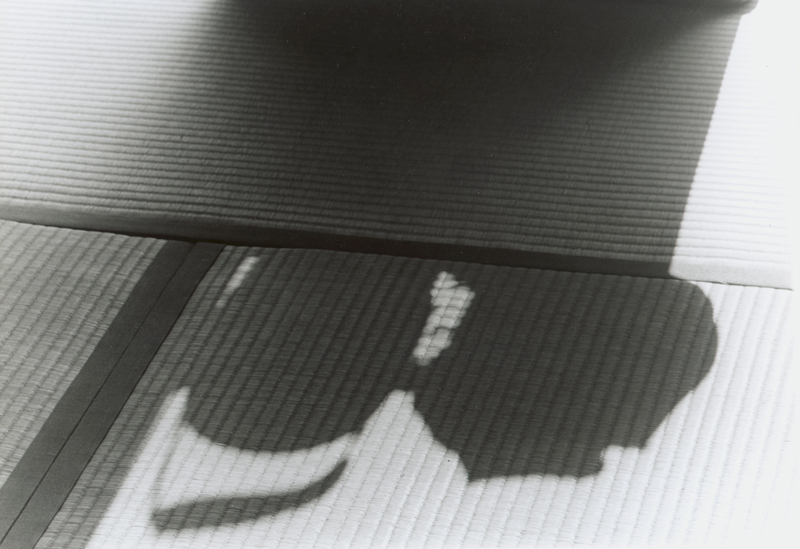
Fig. 17
Theresa Hak Kyung Cha
Two Stills from Exilée, 1980
Super-8 film and video installation; 50 minutes, sound
University of California, Berkeley Art Museum and Pacific Film Archive
Gift of the Theresa Hak Kyung Cha Memorial Foundation © Theresa Hak Kyung Cha
Murdered in New York City in 1982 at the age of 31, Cha left behind her a rich and allusive body of work, including videotapes, book art, collage, and assemblage in addition to an anthology of film theory. 27 (Her performance work, unfortunately, was not documented.) The theoretical sophistication and complexity of Cha’s Work, demonstrated throughout these media, is no less striking than its austere and poetic beauty. A highly refined aesthetic sensibility was joined to a rigorous and speculative intelligence that drew from an equally wide range of disciplines—film theory, linguistics, semiotics, and psychoanalysis. Although protean in form, Cha’s work is quite consistent in its preoccupations, which center on issues of displacement——geographic, cultural, linguistic, historic. Of these it was preeminently language thatfunctioned as the master trope for the wounds of exile. In one artist’s statement, she characterized her work as “looking for the roots of language before it is born on the tip of the tongue.” This temporal “before” is important: it signals Cha’s fascination not only with the materiality of language (Korean, English, or French) in its aural, written, and visual dimensions, but also with its elusive and vocative properties, its links to memory, subjectivity, and the unconscious. And while the well-springs of Cha’s work are related directly to the experience of immigration and exile—the loss of the mother tongue and the trauma of displacement—her work can nonetheless be seen to foreground the difficulty of finding a “language” in which to speak “otherly.” Such a language would be a form of artistic speech that both unshackles the signifier—allows for its free play—yet promotes a form of communion with the spectator, a collaborative production of meaning. This needs to be understood in the context of feminist attempts to remodel and transform those aspects of expression—particularly language—marked by the symbolic structures and logic of patriarchy.
In the 1980 tape Exilée (fig. 17), which in its original form included a film projected upon a screen wall within which the video monitor was placed, Cha explores both the literal, elapsed time of movement from one place to the other (Korea to America, ten hours and 23 minutes) as well as its more abstract and internalized manifestations. Still images of clouds seen from a plane further evoke the sensation of spatial and temporal passage, while Cha’s voice mournfully intones the various losses of exile: “no name/none other than given/last…absent…name/without name/a no name/between name.” In this, as in other works, a linkage is implied between the difficulties of cultural and linguistic displacement and the problematic relations of women to speech and identity.
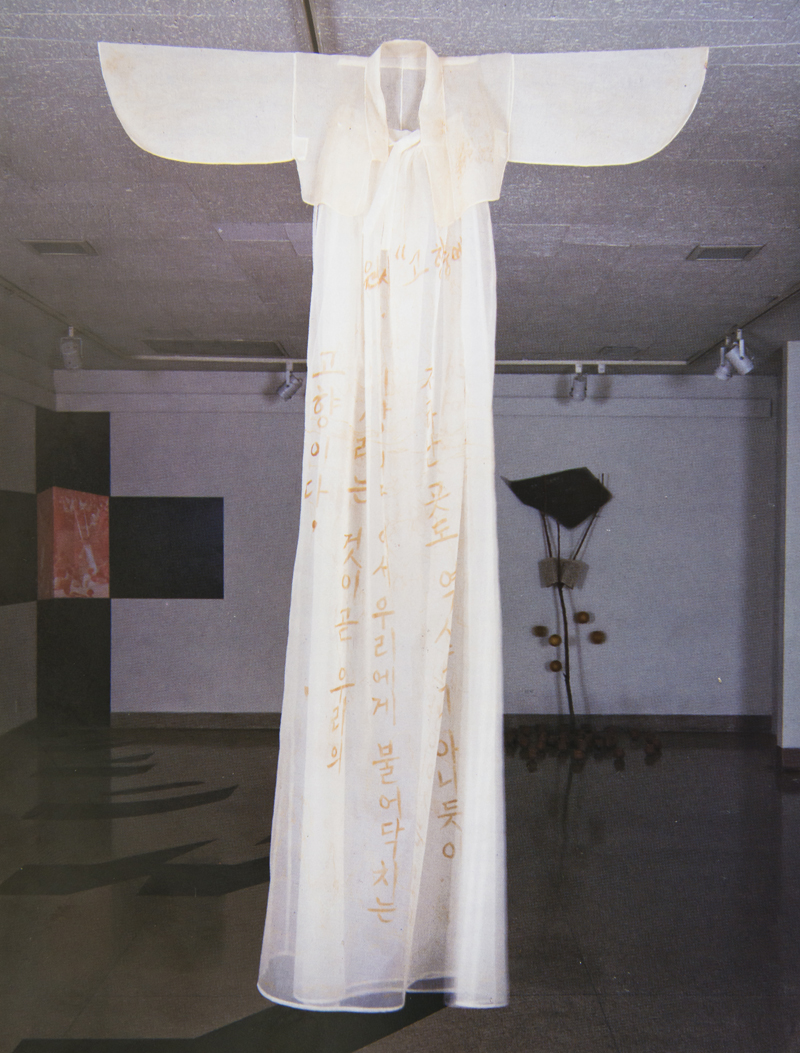
Fig. 18a
Yong Soon Min
deCOLONIZATION, 1991
Mixed media on dress, mylar, and paper Garment, 84 x 84 x 15 in.; four panels, 42 x 25,5 in. each
installation view, Photos : Karen Bell
© Yong Soon Min
Yong Soon Min is almost an exact contemporary of Cha’s, and in fact the two were friends at Berkeley, where both were students in the 1970s. As Min has described her own artistic trajectory, engaging issues of identity as a subject for her art was a consequence of her politicization as a Korean-American woman artist. Women artists of color are, it needs hardly be said, doubly affected by mutually reinforcing operations of racism and sexism.
Like most of the artists in the exhibition, Min must negotiate the double bind of what could be termed the hyphenated artist (e.g., woman-artist, black-woman-artist, Asian-American-woman-artist, etc.). To the extent that such an artist excludes the psychic and cultural components of her own formation, she forecloses the specificity of vision and her art; to the extent that she embraces the singularity of her identity, and makes it an integral aspect of her artmaking, she cedes the high ground of the unhyphenated designation “artist.” At the moment, the art world’s embrace of multiculturalism provides the conditions for the hyphenated artist’s visibility, but whether this represents the fashion of the moment or a substantive shift in aesthetic politics is impossible to know. In any case, Min has herself written about the implications of adjusting art production to the circumstances of Asian—American identity:
…there is much at stake in an attempt to address the identity of a marginalized group such as Asian-Americans and specifically, the artists and the cultural workers of this group who may perhaps be considered to be doubly marginalized. It is not simply a matter of describing the make-up and characteristics of the individual and/or collective identity of Asian-Americans and their cultural production. Our cultural identity has become ever more a contested entity inundated with complex and contradictory claims of authority, authenticity and ownership from a myriad of sources, expected and unexpected. Insofar as much of the primary struggles of Third World people are about land rights and self-determination, our own determination of cultural identity here necessarily also involves a struggle for territory—claiming a place and asserting a position in relation to dominant cultural forces—for our own cultural integrity and well-being. 28
In the installation excerpted from the work entitled deCOLONIZATION (fig. 18a—b), consisting of a seven-foot-long traditional Korean robe and four image/text panels mounted on the wall, Yong Soon Min weaves together the shards of personal history. The presiding metaphors are that of overlay and overlap: the sepia—lettered Korean verse marked on the diaphanous which by virtue of scale is a commanding presence; dense interweaving of photocopied images with texts; the “screen” of frosted mylar through which one views three of the panels; and the mix of biographic reminiscence with literary and historic reference. The poem, entitled “Home,” is repeated in English translation on the back of the robe.
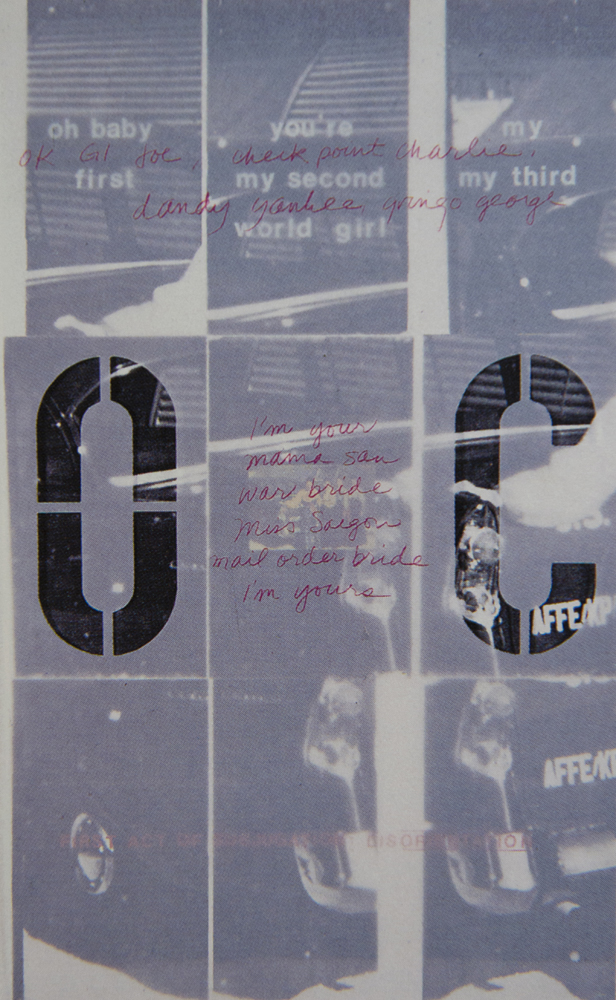
Fig. 18b
Yong Soon Min
deCOLONIZATION, 1991
Mixed media on dress, mylar, and paper Garment, 84 x 84 x 15 in.; four panels, 42 x 25,5 in. each
installation view, Photos : Karen Bell
© Yong Soon Min
Whether the semitransparent robe is to be interpreted as synecdoche for motherland and Korean woman, as one curator has suggested, or as emblematic symbol of a Korea that is as much subjective as geographic, is less significant than the palimpsest-like quality of deCOLONIZATION’s organization, in which different layers of an elusive and mercurial identity are simultaneously in play. Here too, the concept of identity as bricolage seems apposite, given that Min’s deployment of signs of “Koreanness” are at once discrete, decontextualized, aggregate. And to the degree that deCOLONIZATION makes explicit reference to an historic process of self-determination which is nevertheless inscribed with the traces of prior domination (in the case of Korea, by China, by Japan, and, in South Korea, by the U.S.), it reflects as well on the always partial and provisional processes of self-fashioning and self-definition.
Considered in its broadest terms, the problem posed by the interrogative mode in which the artists in Mistaken Identities set out the myriad skeins of subaltern, hyphenated, or neither/nor identities returns to the conditions of political utterance. If, within art practices, identities are presented in all their contingency, ambiguity, irresolution—if the range of possible identities are articulated in all their constructedness—where are the grounds from which to launch an aesthetic politics of entitlement, cultural enfranchisement, and contestation? Is there, one may ask, something like a provisional identity politics, something akin to Gayatri Chakravorty Spivak’s “strategic essentialism” that can be circumstantially claimed, like Baldwin’s garment of identity, but which allows for the heterogeneity and multiple identifications that are equally the province of the individual self?
Clearly it is a political imperative for dominated groups to achieve self-representation, of which visual cultural practices are but one element. In this respect, the act of self-naming is a crucial and empowering activity. Consider, for example, Norma Alarcon’s discussion of the political modalities inhering in the name Chicana:
The name Chicana is not a name that women (or men) are born with, as is often the case with “Mexican,” but rather it is consciously and critically assumed and serves as point of redeparture for dismantling historical conjunctures of crisis, confusion, political and ideological conflict and contradictions of the simultaneous effects of having “no names,” having “many names,” not “know(ing) her names,” and being someone else’s “dreamwork.” However, digging into the historically despised dark (prieto) body in strictly psychological terms, may get her back to the bare bones and marrow, but she may not “find the way back,” to writing her embodied histories. The idea of plural historicized bodies is proposed with respect to the multiple racial constructions of the body since “the discovery.” 29
It is in relation to both my rhetorical questions and to the implications of Alarcon’s text, that I close with a consideration of Armando Rascon’s Artifact with Three Declarations of Independence.
Assembled here are twelve “found”photographs, framed as found, including dust and marks of age and neglect. With the exception of the four portrait snapshots, the pictures consist of familiar stereotypes of “Mexicanness”—the bullfight, the “native” market, the grizzled campesino, the richly adorned sefiorita, the Zorro-like silhouette, and so forth. Below are mounted the three declarations of the installation’s title, manifestos respectively of “El Plan de Delano of 1966” (the founding statement of the Delano Grape Strike, formulated by the nascent Farm Workers Union), the 1967 preamble of the “Plan de la Raza Unida” (the declaration of independence by the Chicano political party “La Raza Unida,” formed in the Texas border town of El Paso), and “The Spiritual Plan of Aztlan” of 1969 (a public resolution adopted at the First National Chicano Youth Conference in conjunction with the Crusade for justice Youth Conference in Denver, Colorado).
These manifestos represent three political moments in the formation of a Chicano political identity and consciousness and three discrete moments of political organization. They trace, in the three-year period of their appearance, an evolution from a politics profoundly informed by religious piety, presided over by the Virgin of Guadalupe, to the affirmation of a “bronze people” with a “bronze culture,” whose presiding myth is that of Aztlan. 30 The declarations trace as well a transition from a discourse of suffering and humility (“we are poor, we are humble, and our only choice is to strike in those ranches where we are not treated with the respect we deserve as working men…”) to the defiance and militancy of the Chicano Youth Conference (“to hell with the nothing race. All power for our people.”).
Counterpointed in Rascon’s installation is, on the one hand, the image world of cultural stereotype—What could be called the Gringo imaginary—mingled with modest, vernacular examples of self-representation (such as the snapshot portrait of the campesino couple)—and on the other, the actual process of political articulation and political/cultural self—definition. It is the space between these two representational “sets” that can be said to constitute the viewer’s share. This space operates as a kind of discursive ellipsis, dividing the domain of conventional and stereotypic representation (in which the Chicano or Mexican exists as object) from the declarations of political agency, in which the participants collectively assert their identity as subjects. Hence, for the non-Chicano/a the instrumentality of Artifact with Three Declarations of Independence resides in how the viewer positions him/herself in relation to both the familiar cultural fantasy and the textual documentation of political struggle—“the subaltern speaks.” Where so much previous postmodern art practice assumed that quotation or appropriation could in itself dissolve the ossified accretions of political and cultural myth, Rascén, like the other artists in Mistaken Identities, instates the historical real, the uneven, erratic but potentially transforming activity of political organization, contestation, and continual struggle that is a catalyst of new identities in the making.
Abigail Solomon Godeau, 1992
This essay was first published in the catalogue of the exhibition “Mistaken Identities”, produced by The University Art Museum, Santa Barbara, California, USA, 1992.
References

